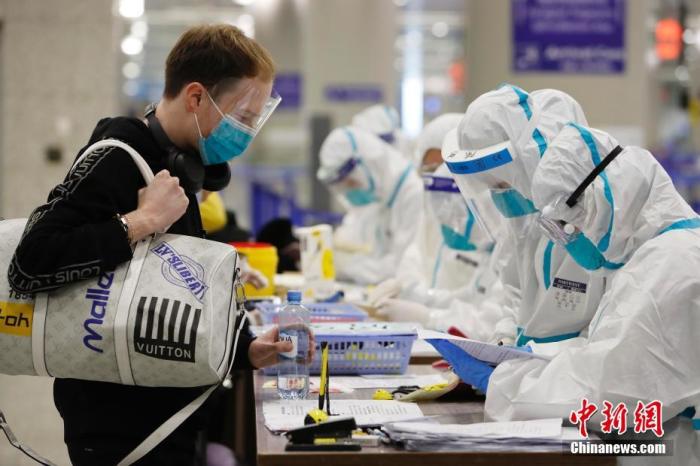China News Service, March 16th. Zhu Tao, Director of the Flight Standards Division of the Civil Aviation Administration of China, introduced on March 16th that the CAAC comprehensively scores flight operation risks based on factors such as the epidemic situation, passenger load factor, and flight operation characteristics of comprehensive flight departure points. . The flight risk is divided into three levels of high, medium and low according to the score, and different prevention and control measures are adopted according to different levels to precisely prevent and control and implement precise measures.
On March 9th, Shanghai Customs personnel checked the information of the health declaration card of the incoming passengers. Photo by China Press Agency reporter Yin Liqin
The State Council ’s joint prevention and control machine is scheduled to hold a press conference on March 16 to introduce the situation of preventing and controlling overseas epidemic import according to law. A reporter asked at the meeting: It is understood that the Civil Aviation Administration classifies inbound flights into three levels of risk: high, middle, and low. What is the basis and standard for the classification? How to prevent and control each level? In addition, what effective measures are there to prevent the import of overseas epidemics?
According to Zhu Tao, the Civil Aviation Administration of China has released the third edition of the "Technical Guide for the Prevention and Control of Epidemics in Transport Airlines and Airports". Based on the previous measures to strengthen ventilation, disinfection, and garbage disposal, comprehensive information on the epidemic situation at the place of departure of the flight, Factors such as passenger load factor and flight operating characteristics are used to comprehensively score flight operating risks. The flight risk is divided into three levels of high, medium and low according to the score, and different prevention and control measures are adopted according to different levels to precisely prevent and control and implement precise measures.
For low-risk flights, the main purpose is to ensure the smooth flow of people at home and abroad. Body temperature tests are performed as needed, and the crew wears disposable medical masks. For medium-risk flights, measures for rationally arranging cabin layout and reducing personnel flow have been added to the measures for low-risk flights. At the same time, according to the voyage, passengers must be temperature-detected during the voyage, and the crew needs to wear medical surgical masks. For high-risk flights, reduce on-board service processes as much as possible, manage passengers by zones, and arrange for passengers to be seated separately. At the same time, separate areas for emergency handling will be reserved in the last three rows of each flight.
According to Zhu Tao, in other aspects of preventing the import of overseas epidemics, the civil aviation department has taken many measures. For example, according to the requirements of the capital's prevention and control mechanism, on March 10, Capital Airport officially opened D area 3 of Terminal 3 as a special treatment area for centralized reception of inbound flights from countries and regions with severe epidemics, setting up passenger arrival areas, transit areas, Observation area, rest area, as well as immigration procedures and security areas. At the same time, with the further development of overseas epidemics. Since yesterday, all international and Hong Kong, Macao, and Taiwan flights at the Capital Airport have been docked at the disposal area. For passengers with abnormal body temperature during the entry process, the Capital Airport has set up special transfer procedures and routes to avoid contact with other passengers.

